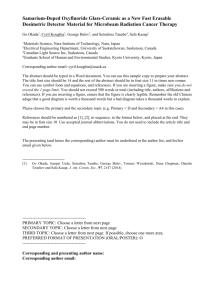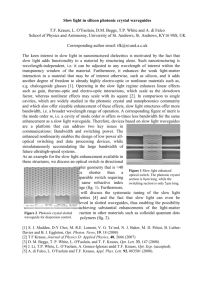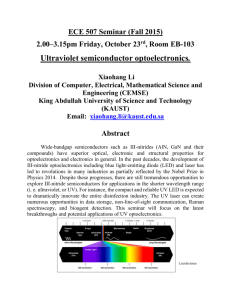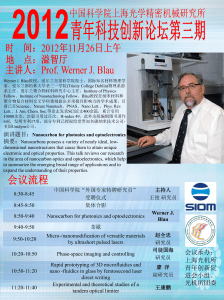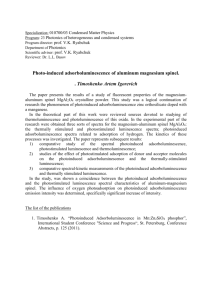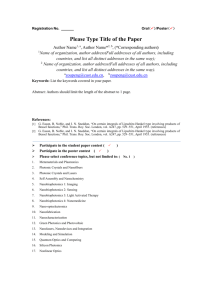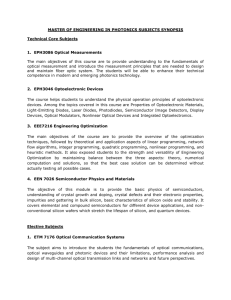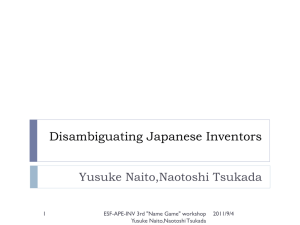Abstract - icoopma 2008
advertisement
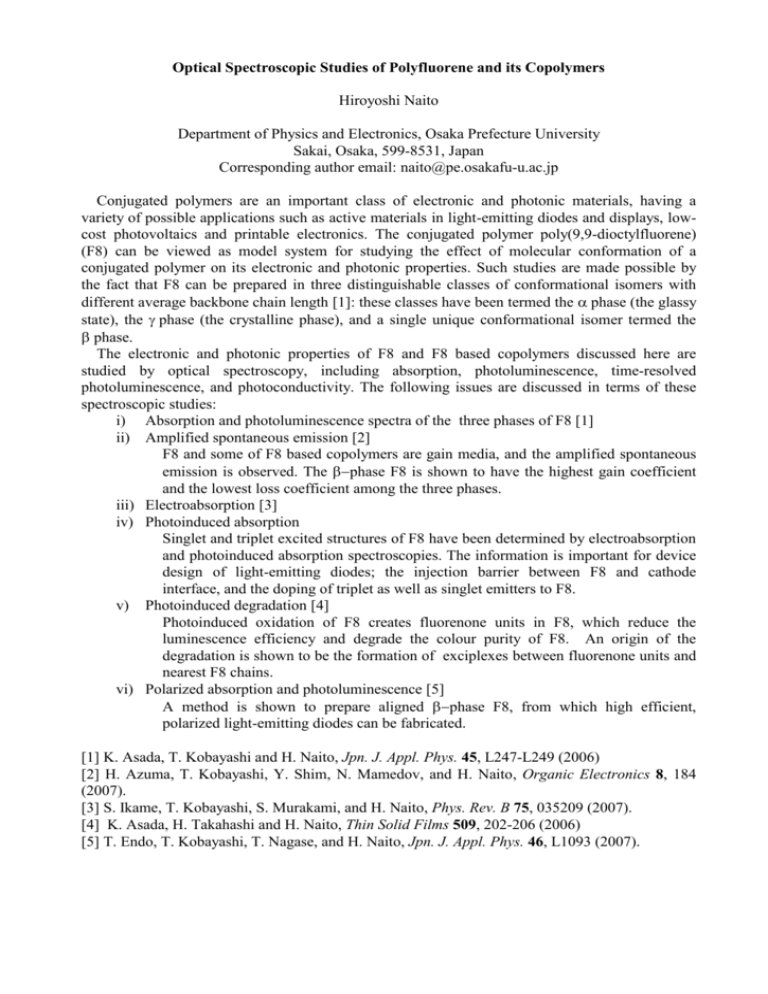
Optical Spectroscopic Studies of Polyfluorene and its Copolymers Hiroyoshi Naito Department of Physics and Electronics, Osaka Prefecture University Sakai, Osaka, 599-8531, Japan Corresponding author email: naito@pe.osakafu-u.ac.jp Conjugated polymers are an important class of electronic and photonic materials, having a variety of possible applications such as active materials in light-emitting diodes and displays, lowcost photovoltaics and printable electronics. The conjugated polymer poly(9,9-dioctylfluorene) (F8) can be viewed as model system for studying the effect of molecular conformation of a conjugated polymer on its electronic and photonic properties. Such studies are made possible by the fact that F8 can be prepared in three distinguishable classes of conformational isomers with different average backbone chain length [1]: these classes have been termed the phase (the glassy state), the phase (the crystalline phase), and a single unique conformational isomer termed the phase. The electronic and photonic properties of F8 and F8 based copolymers discussed here are studied by optical spectroscopy, including absorption, photoluminescence, time-resolved photoluminescence, and photoconductivity. The following issues are discussed in terms of these spectroscopic studies: i) Absorption and photoluminescence spectra of the three phases of F8 [1] ii) Amplified spontaneous emission [2] F8 and some of F8 based copolymers are gain media, and the amplified spontaneous emission is observed. The phase F8 is shown to have the highest gain coefficient and the lowest loss coefficient among the three phases. iii) Electroabsorption [3] iv) Photoinduced absorption Singlet and triplet excited structures of F8 have been determined by electroabsorption and photoinduced absorption spectroscopies. The information is important for device design of light-emitting diodes; the injection barrier between F8 and cathode interface, and the doping of triplet as well as singlet emitters to F8. v) Photoinduced degradation [4] Photoinduced oxidation of F8 creates fluorenone units in F8, which reduce the luminescence efficiency and degrade the colour purity of F8. An origin of the degradation is shown to be the formation of exciplexes between fluorenone units and nearest F8 chains. vi) Polarized absorption and photoluminescence [5] A method is shown to prepare aligned phase F8, from which high efficient, polarized light-emitting diodes can be fabricated. [1] K. Asada, T. Kobayashi and H. Naito, Jpn. J. Appl. Phys. 45, L247-L249 (2006) [2] H. Azuma, T. Kobayashi, Y. Shim, N. Mamedov, and H. Naito, Organic Electronics 8, 184 (2007). [3] S. Ikame, T. Kobayashi, S. Murakami, and H. Naito, Phys. Rev. B 75, 035209 (2007). [4] K. Asada, H. Takahashi and H. Naito, Thin Solid Films 509, 202-206 (2006) [5] T. Endo, T. Kobayashi, T. Nagase, and H. Naito, Jpn. J. Appl. Phys. 46, L1093 (2007). --------------------------------------------PRIMARY TOPIC: J SECONDARY TOPIC: A4 THIRD TOPIC: .L PREFERRED FORMAT OF PRESENTATION (ORAL/POSTER): ORAL: Invited --------------------------------------------Corresponding author name: Hiroyoshi NAITO Corresponding author email: naito@pe.osakafu-u.ac.jp TOPICS Please choose primary and secondary topics A B C D E F G H I J K L M N O P Q R S T U V W X Optical properties of materials A1 General A2 Crystals A3 Polycrystalline bulk and film A4 Amorphous and organics A5 Nanostructures, including photonic crystals Preparation and Characterization of Quantum Dots, Quantum Wires and Other Quantum Structures Excitonic Processes Luminescence, Phosphors, Scintillators and Applications Photoinduced Effects and Applications Photoconductivity and Photogeneration Nonlinear Optical Effects and Applications Electro-Optic Effects and Applications Glasses for Optics, Optoelectronics and Photonics (including ZBLAN, fluozirconate, oxyfluoride and other glasses) Polymers for Optics, Optoelectronics and Photonics Semiconductors for Optoelectronics J1 Semiconductors for Optoelectronics: Wide Bandgap J2 Semiconductors for Optoelectronics: Narrow Bandgap J3 Semiconductors for Optoelectronics: Heterostructures Light Emitting Devices (including organics) Photonic and Optoelectronic Materials and Devices (including devices for telecommunications, laser and detectors) Optical Storage Photovoltaics (materials and devices, and their properties) Waveguides and Integrated Photonics Silicon Photonics Optical Fibers and Fiber Sensors Experimental Techniques Femtosecond Spectroscopy Teraherz (THz) techniques, including materials, emitters and detectors Defect Spectroscopy Plasmons and Surface Plasmons Selected Topics (e.g. Photocatalysts in Materials, Materials for Energy Conversion etc) Abstract submission Deadline: 31 March, 2008 Note: Late abstracts may be considered at the discretion of the conference organizers. Abstract acceptance: 15 April 2008 (Tentative) Manuscripts: To be submitted either before or during the conference using the instructions on the conference website
